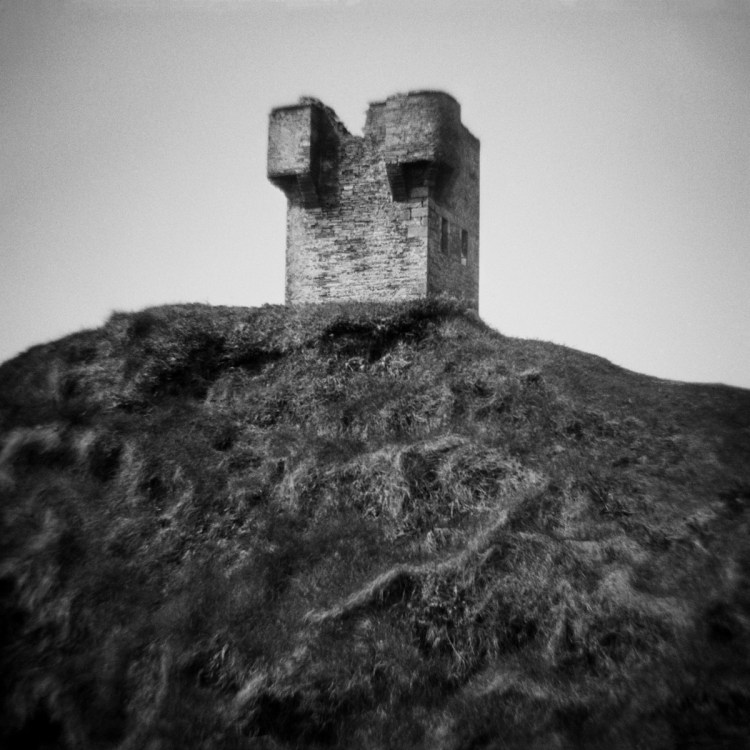Tonee Harbert’s “Ground Signals,” at Speedwell Projects in Portland, is another masterful exhibition featuring 20 black-and-white prints by the Portland-based photographer. Harbert’s works are mostly empty and lonely landscapes, driven by their graininess toward the soft aesthetic of pictorialist photography.
But there are unusual twists and depth to Harbert’s handling of his scenes. They reach out to the viewer with an unexpected sense of the subjective. This assertive sense of reaching is unusual for photography, which we more commonly experience as an image noticed and captured by the photographer. The term “dream-like” leaps to mind, but it falls short after some consideration. Whereas dream imagery blends novel or imagined scenes with memory fragments, Harbert’s pictures strike a tone more like memories degraded by distance and sandblasted by time.

Untitled (stairs in water)
Harbert’s first image, “Untitled (cliff tower),” is a 23-inch square archival pigment print on kozo paper (i.e., high-quality digital printing on a fine Japanese mulberry bark paper) of an ancient and almost bizarrely simple box-shaped crenelated tower with two shoulder-like turrets looking out over a hill. We are gazing up the hill, but the space is impassable, not because of the pitch as much as the dissolving of the grassy slope into photographic grain. Just as we garner physical purchase in the landscape with the weighty stone textures of the (Irish?) tower, we lose it to the immaterial graininess of Harbert’s photographic touch. The result is that we remain where we are, with an image, in that indeterminate space of memory: a present experience of something from another time and place, degraded and uncanny.
It is in this uncanny quality where Harbert’s poetics are most poignant. I was profoundly struck by his “Untitled (stairs in water),” in which a long-ago, titled-away set of concrete steps veers down into deep water past a blurry stone foreground. I know it’s a spot in Washington state, but I can’t imagine a better place for Virgil to have led Dante into the depths of the underworld. The space of the steps is dark, the rock indeterminate, and the water cold as death.
Harbert has a feel for the otherworldly edge of life, particularly with his scenes of trees. He handles the violence inflicted on deer-eaten bushes as though they witnessed the fall of the house of Usher. And he marks “tree without a top” by high tension wires in the space of the photo where the treetop should be, as though it were unnaturally garrotted. Most impressively, he gives us a 60-inch triptych of a clear-cut mountaintop seen from such a distance that the stumps set up pixelating rhythms that rhyme with his exquisite graining, dripping at the edges with distortion.

Untitled (clear cut triptych) Photo courtesy of Tonee Harbert
However desolate these descriptions sound, the images never fall to sadness. There is tension and doubt. And if they were memories, then we survived long ago to see them at such a distance. They are more about something lost and found than simply the sense of loss.
Harbert does not lack for a sense of the dramatic and the picturesque. The image of a couple on a precipice (Ireland again?) is like if the Romanticist Caspar David Friedrich painted a deco-era car grill mountain from the kids’ movie “Cars.” It’s almost bizarrely striking. He gives us a wooden path into the landscape (Alaska?) that seems to be swallowed by the empty hills ahead. He grasps the fleeting image of a “V” of speck-like geese in distant formation. He gives us a scene of a field being burned, and yet we notice that one of the fires is throwing black smoke instead of white and what is burning is not the fallow field but maybe a vehicle. It is thick with mystery.

Untitled (field fire)
A particularly nuanced image is “Untitled (water view),” a view through impassibly scraggly coastal bushes centered on a handsomely narrow pole. What looks like a fog-softened distant island turns this into a cross, an otherworldly vision seemingly from a worthy quest.
Harbert has an extraordinary sense of balancing composition with image texture and the textures of his own photographic process. He blends narrative seamlessly with mystery. His images are dark but undeniably compelling and beautiful. Underlying his sense of scene, of course, is extraordinary technique. Harbert uses a 1960s-era Diana camera – a completely plastic apparatus (including a plastic lens) that was designed to make photography affordable. In Harbert’s hands, its shortcomings become its strengths. The softness becomes aesthetic, and its distortions become deliciously delirious quirks. Personally, I love the soupy graininess of quick-shot, black-and-white film, but Harbert achieves this effect with intention and determination. We can practically feel that in the digital part of this film-originated photography: Harbert works the flavors of the grain like a master chef.
A particularly satisfying aspect of “Ground Signals” is the shift from seeing the work in person to remembering it later. In the flesh, you can bask in the material qualities of the photographs. But the images are strong enough (some are even haunting) to remain in your memory. And something wondrous and strange happens to them there: They become your own memories – the stuff of dreams.
Freelance writer Daniel Kany is an art historian who lives in Cumberland. He can be contacted at:
dankany@gmail.com
Send questions/comments to the editors.



Success. Please wait for the page to reload. If the page does not reload within 5 seconds, please refresh the page.
Enter your email and password to access comments.
Hi, to comment on stories you must . This profile is in addition to your subscription and website login.
Already have a commenting profile? .
Invalid username/password.
Please check your email to confirm and complete your registration.
Only subscribers are eligible to post comments. Please subscribe or login first for digital access. Here’s why.
Use the form below to reset your password. When you've submitted your account email, we will send an email with a reset code.